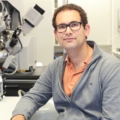In situ architecture of neuronal α-Synuclein inclusions
Output Details
Preprint August 7, 2020
Description
α-Synuclein (α-Syn) aggregation is a hallmark of devastating neurodegenerative disorders including Parkinson’s disease (PD) and multiple systems atrophy (MSA). α-Syn aggregates spread throughout the brain during disease progression, suggesting mechanisms of intercellular seeding. Formation of α-Syn amyloid fibrils is observed *in vitro *and fibrillar α-Syn has been purified from patient brains, but recent reports questioned whether disease-relevant α-Syn aggregates are fibrillar in structure. Here we use cryo-electron tomography (cryo-ET) to image neuronal Lewy body-like α-Syn inclusions *in situ* at molecular resolution. We show that the inclusions consist of α-Syn fibrils crisscrossing a variety of cellular organelles such as the endoplasmic reticulum (ER), mitochondria and autophagic structures, without interacting with membranes directly. Neuronal inclusions seeded by recombinant or MSA patient-derived α-Syn aggregates have overall similar architecture, although MSA-seeded fibrils show higher structural flexibility. Using gold-labeled seeds we find that aggregate nucleation is predominantly mediated by α-Syn oligomers, with fibrils growing unidirectionally from the seed. Our results conclusively demonstrate that neuronal α-Syn inclusions contain α-Syn fibrils intermixed with cellular membranes, and illuminate the mechanism of aggregate nucleation.
Article published in Nature Communications on 14 April 2021. Initial preprint 10.1101/2020.08.07.234138 posted on BioRvix on 07 August 2020.
Identifier (DOI)
10.1038/s41467-021-22108-0




